- What Is On-Page SEO?
- Why On-Page SEO Matters
- On-Page SEO Checklist: 14 Effective Strategies
- 1. Keyword Research and Optimization
- 2. Content Quality and Relevance
- 3. Title Tags and Meta Descriptions
- 4. Header Tags (H1, H2, H3, etc.)
- 5. URL Structure
- 6. Internal Linking
- 7. Image Optimization
- 8. Mobile Friendliness
- 9. Page Speed Optimization
- 10. Schema Markup and Structured Data
- 11. Social Sharing Integration
- 12. Secure Website (HTTPS)
- 13. Content Updates and Freshness
- 14. Call-to-Action (CTA) and Conversions
- Tools to Help With On-Page SEO
- Common Mistakes of On-Page SEO Checklist That You Must Avoid
- Conclusion
- Frequently Asked Questions (FAQs)
- Q1. What is on-page SEO, and why is it important?
- Q2. How to conduct effective keyword research and optimization?
- Q3. What are the essential elements of an on-page SEO checklist?
- Q4. Why are mobile friendliness and page speed critical for SEO?
- Q5. What common mistakes based on this on-page SEO checklist should be avoided?
On-Page SEO Checklist – The Complete Guide
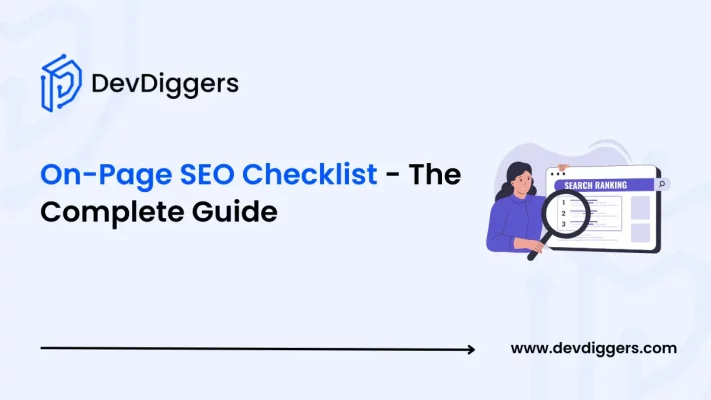
On-page SEO becomes very important for your online site when it comes to improving the visibility and reach of your website. This blog will teach you the complete on-page SEO checklist to enhance your website’s ranking.
The on-page SEO is about making every part of your website search engine-friendly so that your website reaches the correct users. There are multiple things when it comes to on-page SEO, such as keyword research, page speed optimization, and many more.
You will get to know what all of these are about, why they are important for a better ranking of your site, and even some helpful tips on how to cover them.
What Is On-Page SEO?
On-page SEO involves optimizing each single web page of your website to rank higher, along with a higher rate of traffic in search engines. It’s way different from off-page SEO, which involves things such as creating backlinks.
In on-page SEO, you need to deal with some essential factors of your website. These include content quality, HTML code, images, and user experience. The goal here is to make the search engines understand what your page is all about and how helpful it is to users.
Why On-Page SEO Matters
Before jumping straight into the entire checklist for on-page SEO, here are a few points to understand why on-page SEO is crucial for your website.
- Better Rankings: Search engines are dependent on the on-page SEO of your site to understand the relevance of your page for a particular search query that the users enter. By focusing on the on-page SEO for your site, you provide your site with a higher chance of ranking.
- Better User Experience: If your website is optimized well. It is good not only for search engines but also for your users. It also ensures that your content is organized well, along with greater readability and usability, and makes it more informative.
- More Organic Traffic: A good on-page SEO always leads to more traffic to your site through organic searches, which further improves the growth rate of your website.
- Platform for Other SEO Activities: A -plenty of activities that are related to off-page SEO, such as link building, are based on a solid on-page platform. If you do not optimize your content, even the most effective off-page activities might not provide the desired results.
On-Page SEO Checklist: 14 Effective Strategies
Here is the complete on-page SEO checklist for you to optimize your web pages.
1. Keyword Research and Optimization
Step 1: Identify Your Target Keywords
You first need to understand the keywords that your audience is likely to search for before you start creating and editing your content. You can use any tool for keyword researching to look for the relevant words or terms that are similar to your content, and have a higher reach.
Also, remember that the keywords, which are long phrases, also called long-tail keywords, have a higher reach and are easier to rank and attract traffic to your site.
You can easily get a few of the long-tail keywords for your site simply from Google Searches. Simply, just type any keyword in the Google search bar, but don’t hit enter from your keyboard or click on the Google Search button. Instead, check out the keywords that Google shows you, especially those that appear first as suggestions for your site.
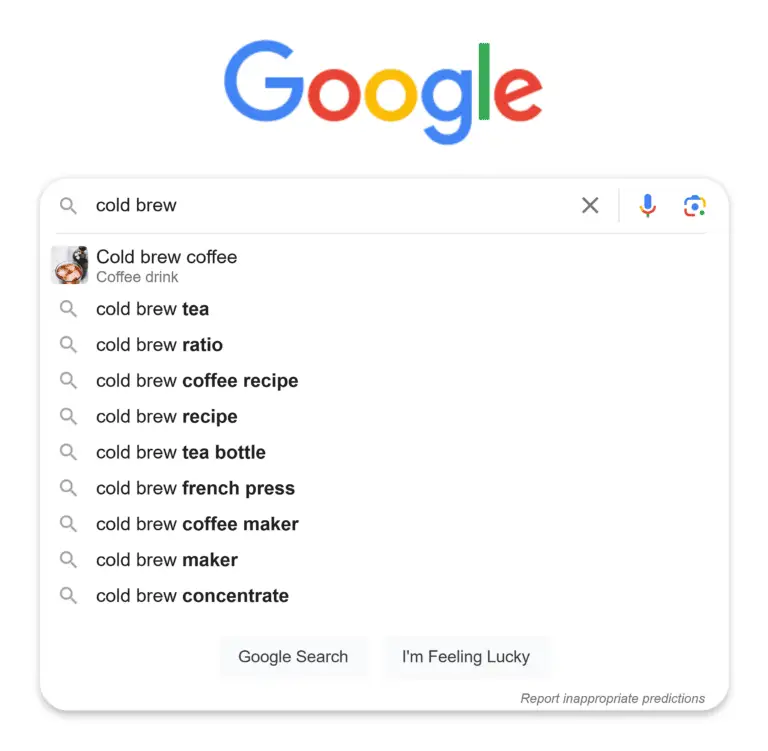
Step 2: Use Keywords Naturally
Now is the time to use these researched keywords in your content. You can add these keywords in your blog titles, headings, and even the body section.
Also, you need to ensure that you do not overuse the keywords; the keywords must be inserted in between the text naturally, not by forcing them to increase the SEO score. Since overusing the keywords or simply keyword stuffing can degrade your site’s ranking.
For example, let’s say you want to rank for How to Add Pages In WordPress. To integrate the relevant keywords in your content, you need to first use the exact keyword in a few places in your content. You can also take the help of some synonyms such as “How to Insert Pages in WordPress”, “Adding Pages in WordPress”, “How to Setup Pages in WordPress”, etc.
Once you are done with this, you can then use the LSI (latent semantic indexing) keywords. These are the keywords that you can use along with your main keyword but are relevant to the main or the focus keyword. In this case, you can use “WordPress”, “Adding page”, “Pages in WordPress”, etc.
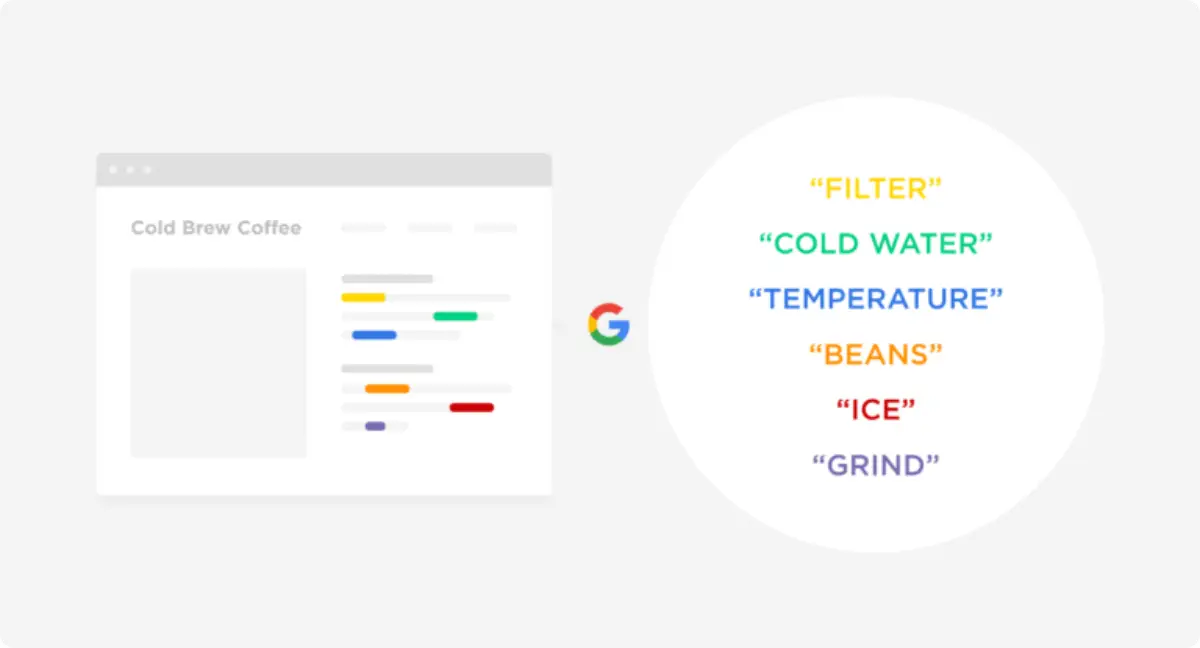
Step 3: Focus on Search Intent
You need to check your users’ demands. Do they want to have a detailed guide, quick answers in the form of FAQs, or simply some step-by-step instructions? This means that your content must be inclined towards the intent behind using the specific keywords.
This also involves understanding the search intensity of your users. This alignment between content and intent is a very crucial signal for the search engines behind ranking your site.
2. Content Quality and Relevance
Step 1: Write for Your Audience
You need to make sure that the content you are writing solves any specific problem of the users. Your site visitors click on your site just to find a specific answer to their query, and your content must be inclined to provide their answers.
Always keep your writing simple and easy so that even the most complex topic seems easier to the user.
Step 2: Structure Your Content
You can divide your entire content into different logical sections with the help of headings and subheadings using the H2 and H3 tags.
This approach improves the readability of your content and also allows search engines to understand the hierarchy of the information in your content. You can even use bullet or numbered lists to make certain sections of your content clearer to understand.
Here is the structure for the blog Do WordPress Tags Help SEO?
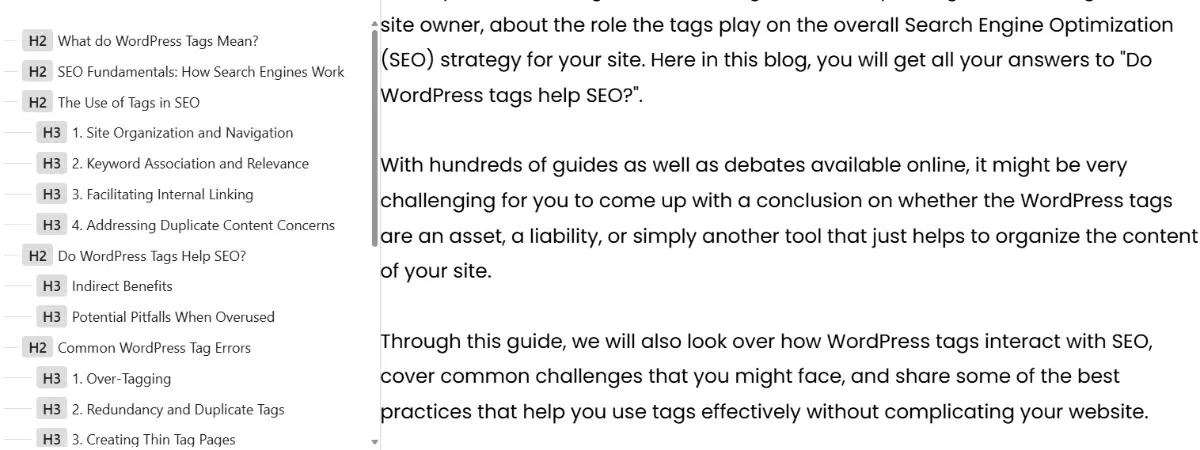
Step 3: Update Regularly
Always make sure to update the information in your content regularly, along with including the focus keyword in a few more places. This approach is a must in case your content deals with a fast-changing industry.
3. Title Tags and Meta Descriptions
Step 1: Craft Compelling Title Tags
The foremost thing that any user would probably look for in your blog is the title. Not only will your user, but also the search engines will also focus on the title first. Always ensure that the title you provide perfectly describes the entire content of that page and that it also includes the primary keyword you set.
Your title must also be 50-60 characters so that it becomes fully visible in the search results. For instance, this blog discusses the importance of WordPress tags in SEO building. Here, look over the title of the blog.

The title of the blog includes the primary keyword for the blog.
Step 2: Write Effective Meta Descriptions
The meta-description of your blog will not directly impact your rankings, but it affects the click-through rates. You must write a concise meta description that provides a clear summary of the content of your blog.
The meta description must range between 150-160 characters and also include the focus keyword so that whenever your users enter their search queries, they can see it.

4. Header Tags (H1, H2, H3, etc.)
Step 1: Use One H1 Tag per Page
The H1 tag is the main heading on your page. It should be used to introduce the topic and include your primary keyword. There should only be one H1 tag per page to make the structure of your content clear.
Step 2: Organize Content with H2s and H3s
Subheadings such as H2, H3, etc., help break your content into sections. They help guide your users through your article and help search engines understand what topics are covered. Make sure your subheadings are descriptive and include secondary keywords wherever relevant.
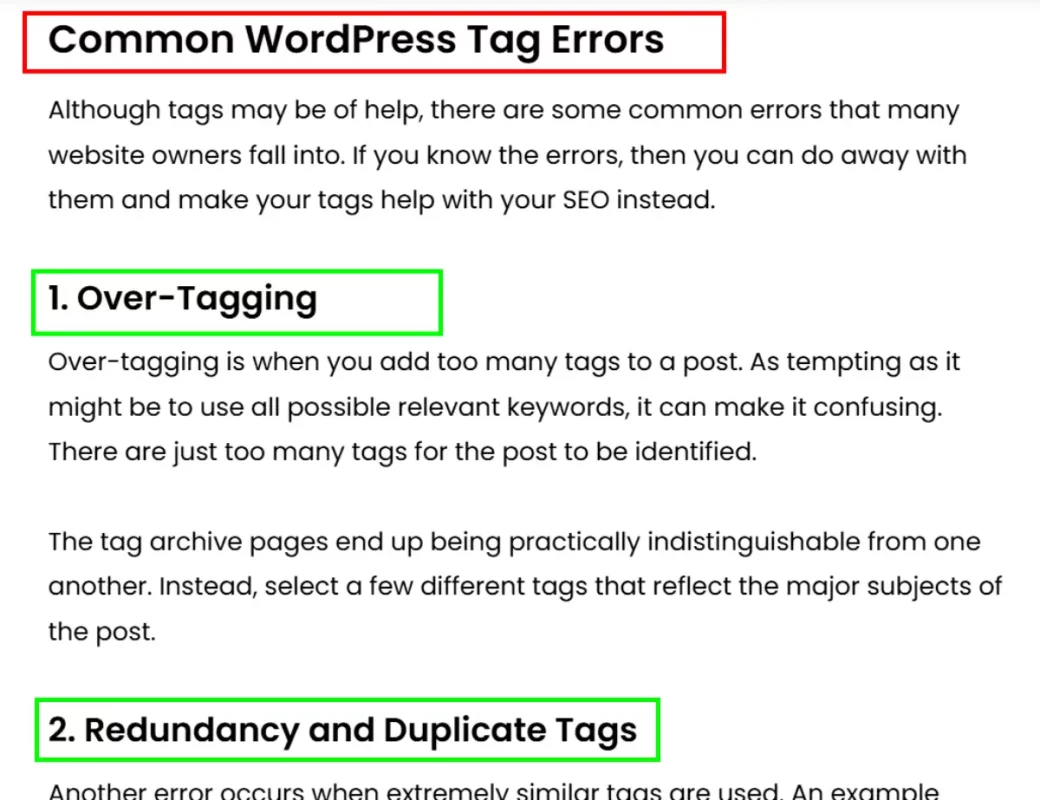
Here, the red box indicates the use of the H2 tag and the green ones are for the H3 tags.
5. URL Structure
Step 1: Keep URLs Short and Descriptive
If the URL for your content page is clear and straightforward, it becomes easier for search engines to analyze the structure of your page. Always try to avoid having long, confusing URLs with unnecessary parameters; rather, use concise ones.
Also, short URLs rank best in Google, according to standard data.
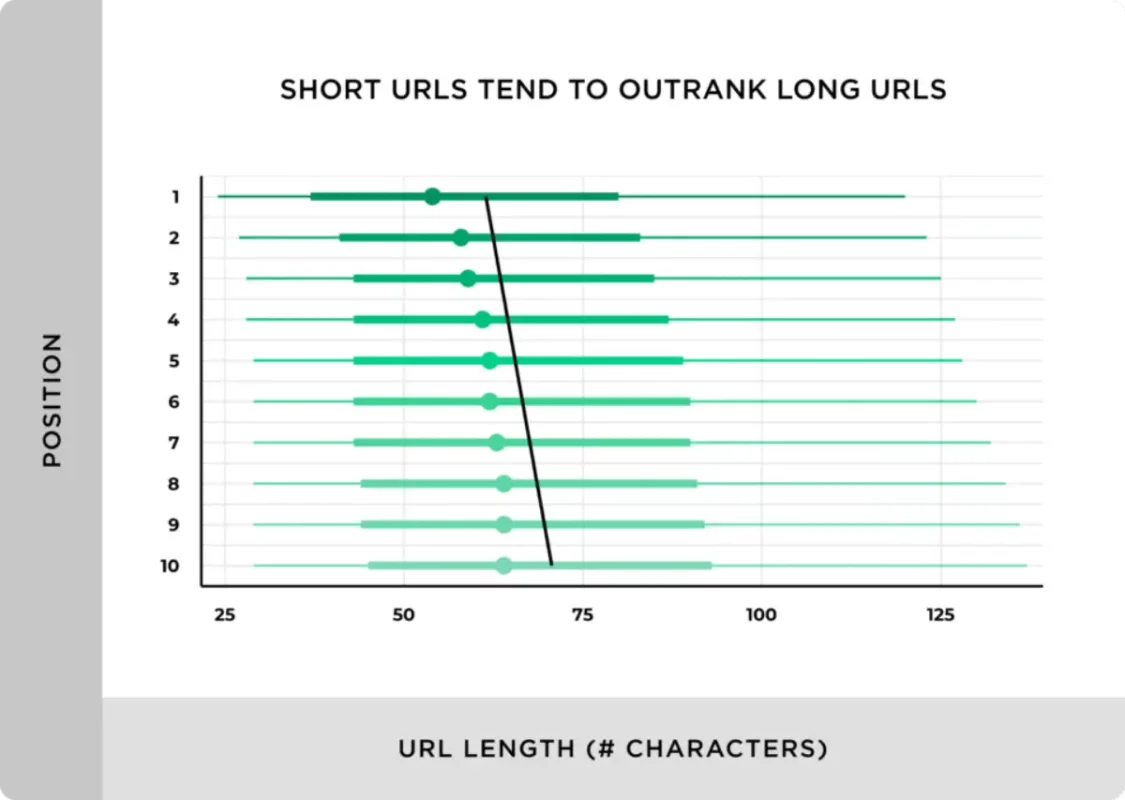
Step 2: Use Hyphens to Separate Words
Insert hyphens (-) in between the words of the URL instead of underscores (_). Hyphens make it much easier for search engines to interpret the URL, which further improves the ranking of your page.

6. Internal Linking
Step 1: Link to Relevant Content
When you include the internal links, the link equity increases throughout your website, which means the content helps your users to get connected to another similar content page of your website. So, whenever writing an article, try to link similar other pages or posts to your content.

Step 2: Use Descriptive Anchor Text
Also, try to use anchor text that defines the content you are linking to on your page. For instance, if your content is about different tools for SEO and marketing, you can keep the anchor text as – 10 Most Useful Tools for Blogging, SEO, and Marketing.
So, in this example, instead of using some generic text such as click here, you are using phrases that include your focus keywords and offer a clear context.
7. Image Optimization
Step 1: Use Relevant, High-Quality Images
Including images in your content helps to improve the user engagement of your page. But, you need to ensure that the images that you are using are optimized, since an unoptimized image might make your site slow.
Always use high-quality images that are relevant to your content, and always include descriptive alt text that contains keywords wherever appropriate. Here, you also need to avoid keyword stuffing.
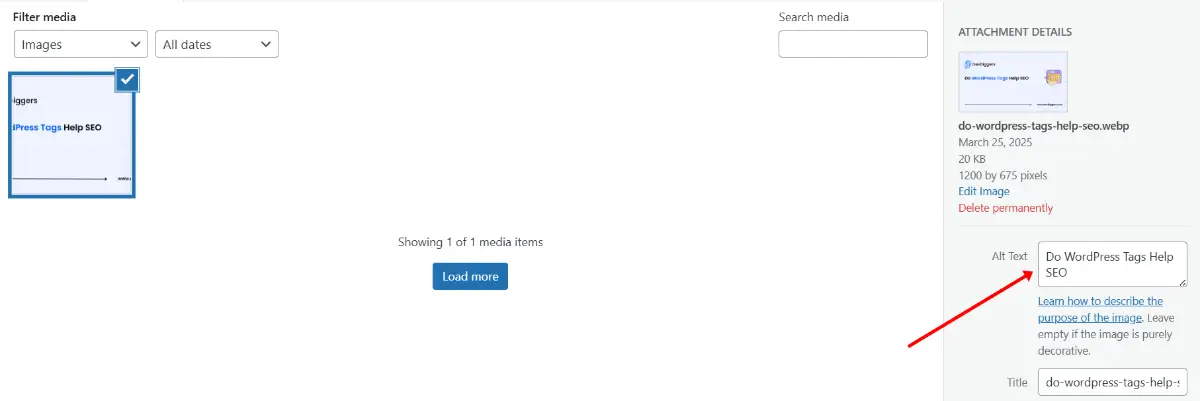
Step 2: Compress Images for Faster Loading
If the image size is very large, it might make your site slow since so much time will be wasted on loading the image. You can use specific tools to compress the images without compromising the quality.
Also, make sure that the image is in .webp format. Faster loading times lead to a better user experience and can indirectly improve your rankings.
Step 3: Use Descriptive File Names
Always use descriptive file names for your images. For instance, if your image is about Do WordPress Tags Help SEO, use the name for your image file as do-wordpress-tags-help-seo.webp instead of using any generic name like image1.jpg. You can also check this guide on how to name images for SEO to get detailed information.
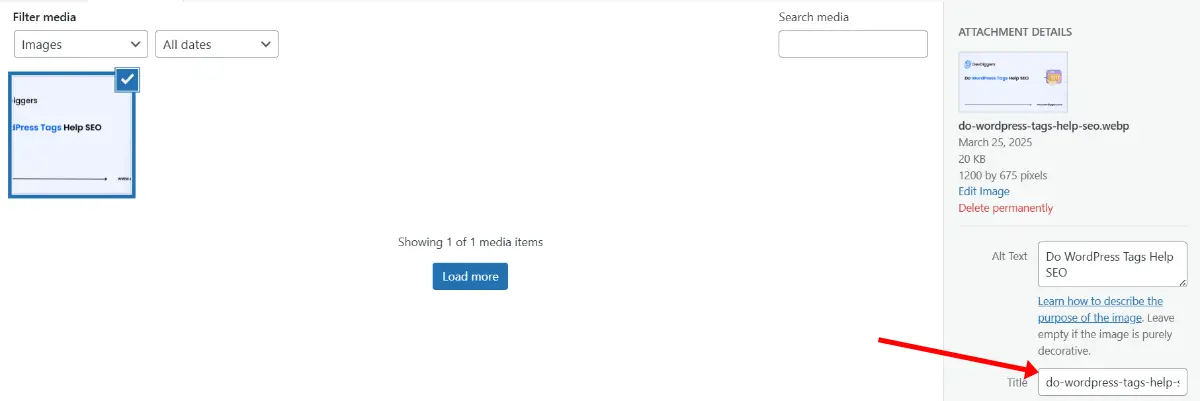
8. Mobile Friendliness
Step 1: Ensure Responsive Design
Since most of the users are now shifted towards mobile devices, you also need to ensure that your content has a responsive design.
Having a responsive design structure, your website automatically gets adjusted to the screen size of any device. This also helps improve the user experience as well as the SEO.
Step 2: Test Mobile Usability
You can use Google’s Mobile-Friendly Test to ensure that your content pages are optimized for mobile devices. If you find issues, you need to work on fixing them to make sure that your site is accessible to all users.
9. Page Speed Optimization
Step 1: Improve Loading Times
If your website is slow, it might lead to increased bounce rates, which negatively impact the SEO of your site and degrade its ranking. To fix a slow site, you need to improve the page speed of your webpage.
For that, reduce the use of heavy scripts, enable the option for browser caching, and use a content delivery network, the CDN.
Step 2: Use Tools to Monitor Performance
There are plenty of tools to monitor the performance of your site, among which Core Web Vital is the one you can use. This free tool offers valuable data on the performance of your site.
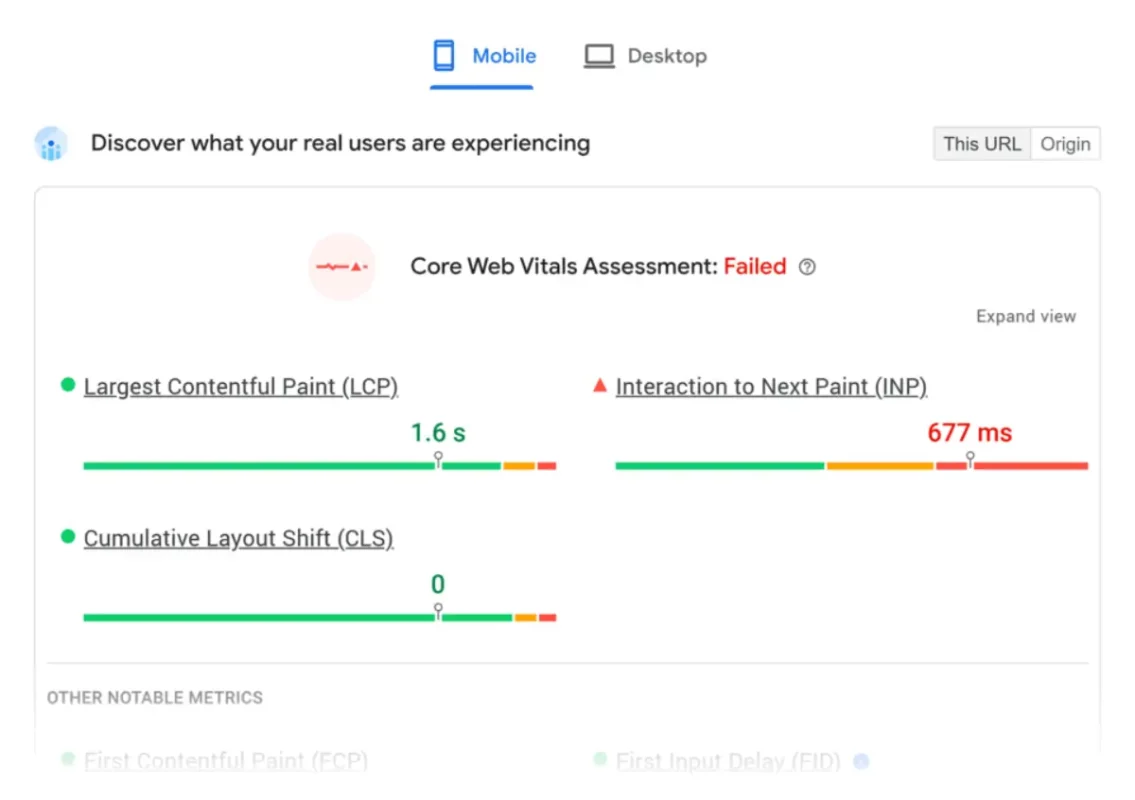
The tool also provides suggestions for improvement like this.
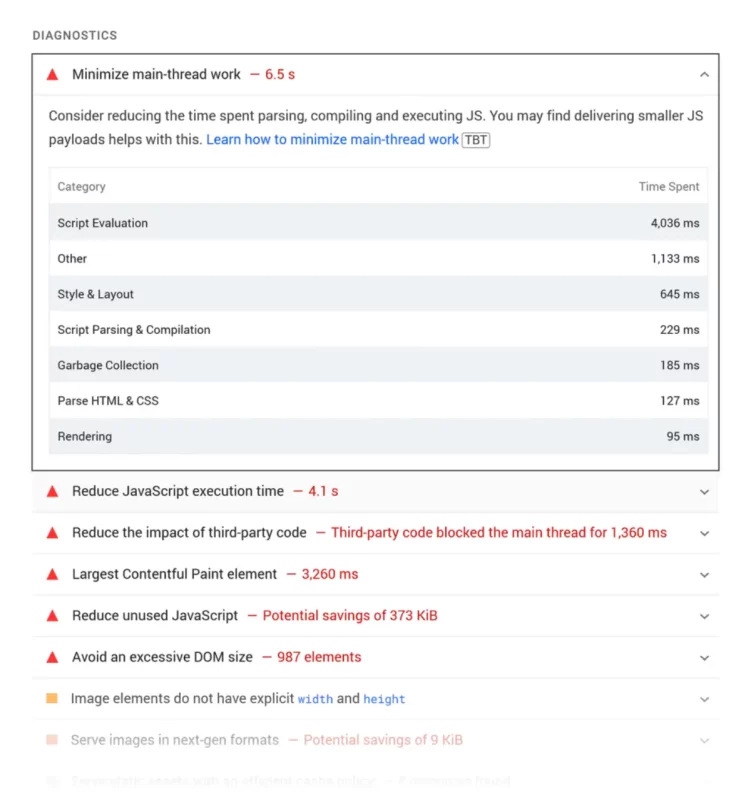
10. Schema Markup and Structured Data
Step 1: Use Schema to Enhance Search Results
If you want the search engines to understand the entire content of your webpage better, you need to follow structured data for the schema markup. This might include star ratings, reviews, or event details, depending on the content of your site.

Step 2: Validate Your Schema
Once you have added the schema markup to your pages, you can use Google’s Rich Results Test to ensure that it is implemented correctly. Correctly structured data can improve click-through rates by making your listings stand out.
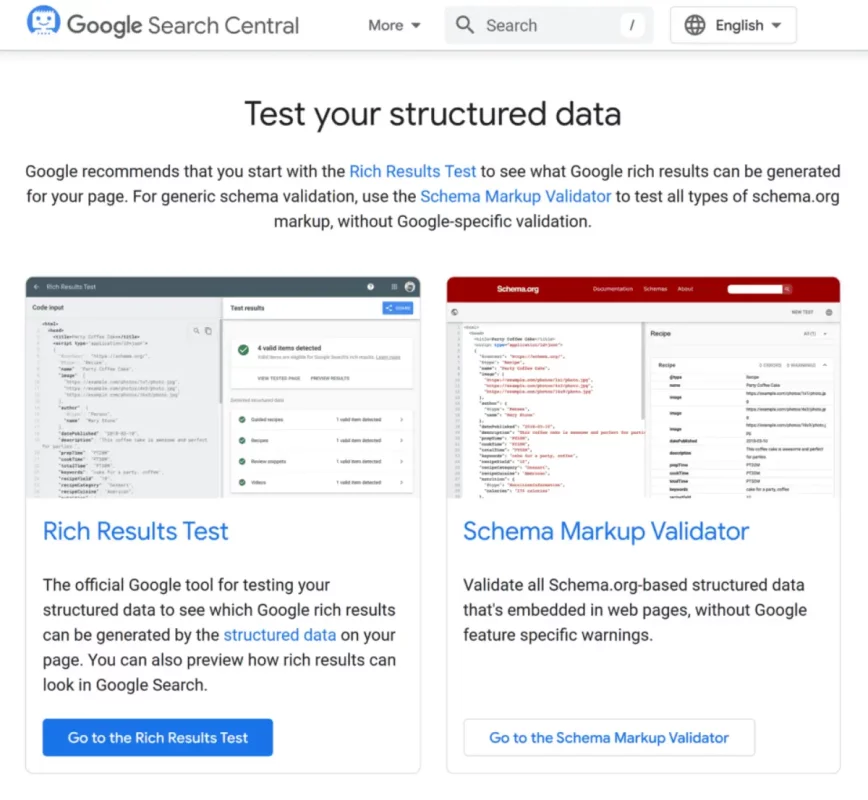
11. Social Sharing Integration
Step 1: Add Social Sharing Buttons
Including social sharing buttons on your content pages helps your visitors to share your content on platforms such as Facebook, Twitter, and LinkedIn. This not only increases the reach of your content but also tells the search engines that your content is popular.
Step 2: Optimize Open Graph Data
Open Graph meta tags help control how your content is visible to your users, along with when it is shared on social media. You also need to ensure that your pages contain the correct title, description, and image set up for social platforms.
12. Secure Website (HTTPS)
Step 1: Use SSL Certificates
Security is an important ranking factor for any website. You need to ensure that your website uses HTTPS by installing an SSL certificate. This reassures your visitors that your site is secure and also builds trust.

Step 2: Regularly Update Security Measures
Always regularly update the security protocols for your website. Regularly update your content management system the CMS and plugins to avoid any kind of risks that might affect the SEO of your site.
13. Content Updates and Freshness
Step 1: Regularly Revise Old Content
Search engines prefer up-to-date and new content. That’s why you need to go through your older posts and refresh them with new information. This keeps the content of good quality and indicates to search engines that your site is active.
Step 2: Add New Sections or Information
If your older articles seem to be lacking the relevant information as compared to the recent content, you need to think about creating new sections or making the existing ones longer. Not only does this enhance the quality of your post, but it also gets your post ranked for more keywords.
14. Call-to-Action (CTA) and Conversions
Step 1: Include Clear CTAs
Though the goal of on-page SEO is to increase the number of organic visitors to your site, the major objective behind this often involves the conversion of visitors to customers or subscribers.
You need to include distinct and apparent calls-to-action that direct the users toward a specific action, such as subscribing to a newsletter, downloading a white paper, etc.
Step 2: Test and Optimize CTAs
Review your CTAs regularly to check how they are performing. Even the smallest changes in wording, color, or placement can have a significant impact on the conversion rates for your site.
Tools to Help With On-Page SEO
Here is a list of various tools that you can include as a part of your on-page SEO checklist, for your site.
- Google Search Console: Google Search Console provides insights into how your website performs according to the various search results of Google. It also alerts you to issues related to crawl errors or mobile usability problems.
- Google Analytics: Google Analytics helps track your website traffic, user behavior, and engagement metrics so that you can easily measure the effectiveness of your on-page SEO efforts.
- Yoast SEO: Yoast SEO is one of the most popular plugins for WordPress, which helps you optimize your content and manage technical SEO elements such as sitemaps and robots.txt.
- Semrush: Semrush is a tool that offers some other tools for keyword research, competitor analysis, and site audits. It also helps you identify and fix some technical SEO issues.
- PageSpeed Insights: PageSpeed Insights helps analyze the performance of your web content pages and offers suggestions for improving load times.
- Mobile-Friendly Test: Google uses a simple tool to ensure your website works well on mobile devices.
Common Mistakes of On-Page SEO Checklist That You Must Avoid
Even after having a complete checklist for on-page SEO in hand, it is very easy to make mistakes that could harm your website rankings.
- Keyword Stuffing: Overusing keywords makes your content look artificial. Always go for readable content with a natural flow.
- Duplicate Content: Ensure that each page contains unique content. Duplicate content might confuse the search engines and reduce your site’s rankings.
- Ignoring Mobile Optimization: With the majority of users shifting towards mobile devices and their searches, using a responsive design structure for your site is a must for better user engagement and SEO.
- Slow Page Speed: Large images, unoptimized code, and excessive scripts can all contribute to the slow load times of your page. Regularly audit your website for performance issues.
- Poor Internal Linking: Not linking to other relevant pages on your site can limit your users’ ability to navigate and discover related content.
Conclusion
To sum it up, it will take time and effort to implement this on-page SEO checklist, but the long-term rewards, such as better rankings, more organic traffic, and greater user engagement, are well worth it.
Begin with the fundamentals, and continuously check your progress to adjust to any shifts in search engine algorithms or user patterns.
Following this on-page SEO checklist is a continuous process, and with each optimization you make, you get that much closer to realizing your digital marketing objectives.
So, get down to business, use this checklist, and see your website become more noticeable and worthy for both your users and the search engines.
Frequently Asked Questions (FAQs)
Q1. What is on-page SEO, and why is it important?
On-page SEO involves optimizing the individual pages of your website, such as content, code, and images, to improve the rankings, traffic, and user experience.
Q2. How to conduct effective keyword research and optimization?
Identify the target and long-tail keywords, then use them naturally in titles, headings, and body content to match the search intent of your users.
Q3. What are the essential elements of an on-page SEO checklist?
The most essential elements of an on-page SEO checklist are the use of clear title tags, concise meta descriptions, structured header tags, descriptive URLs, and proper internal linking.
Q4. Why are mobile friendliness and page speed critical for SEO?
Responsive design and fast loading improve the user experience, along with reducing bounce rates, which directly impact the search rankings of your page.
Q5. What common mistakes based on this on-page SEO checklist should be avoided?
Avoid keyword stuffing, duplicate content, poor internal linking, and unoptimized images that can slow your website and decrease your site’s rankings.

Sagnika Goswami
Hi, I’m Sagnika Goswami. I am a tech enthusiast with a knack for content writing. Read my blogs for your daily insights.


Leave a Reply